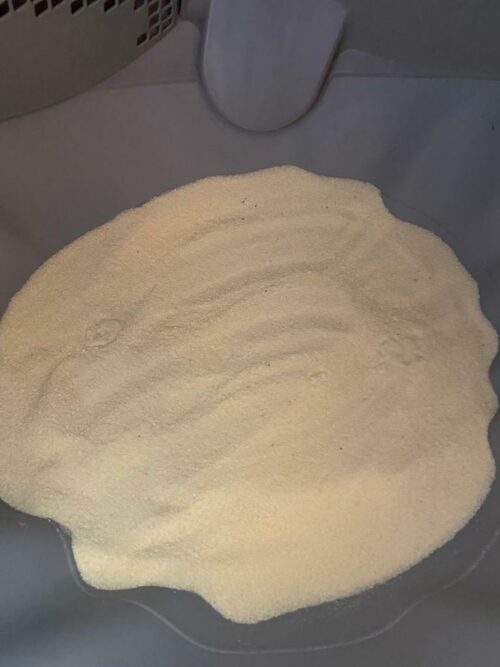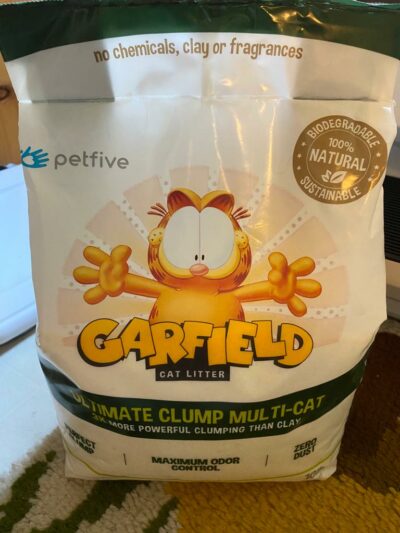
Since I got the Litter Robot 3 back in 2016 and now using the new Litter Robot 4, I have tried a lot of different brands of clumping clay litter in order to find the most suitable. In fact, I created the article best cat litter to use with the Litter Robot as a way to help cat owners to find the best one without going through so many trials and errors. This helps to save money too! But in this experimentation with different brands, I have always used clumping clay litter (as an exception, I tested crystals with the Robot once). By including only clay litters on my list I left out people who are thinking of getting the Litter Robot but whose cats are used to corn cat litter; they want to know if corn cat litter works with the Robot. That’s why I created this review to see how this type of natural cat litter works with one of the most popular automatic litter boxes.
Why Did I Pick Corn Litter?
I wanted to provide my experience using this type of litter. Many people don’t like the chemicals that are involved in the clay-clumping litter. They are into natural components that are friendly to the environment, although there are some risks of mold formation in corn litter. All in all, some cat owners prefer corn litter for many reasons and one of them is that it doesn’t create dust.
How Corn Litter is Made?
Either pellets of a more sandy corn litter (which is the type I used for this article) the corn components, kernels or cob, are grounded and exposed to high temperatures. The main component of corn litter could be solely corn kernels or corn cob, but the mixture will depend on the brand. Whatever the components and the process may be, corn litter is highly biodegradable. Actually, the USDA Agricultural Research Service (ARS) scientists discovered a way to make corn litter that is 100% biodegradable by using spent grains left over from corn ethanol production (source). How cool is that!
Corn Clumping Litter I Used for my Experiment
I didn’t research a lot to pick a particular brand of corn cat litter, I simply wanted to try it for over a week and see if it works well with the Litter Robot. In order to do this, I wanted a sand-type corn litter because this way it works smoothly with the sifting screen of the Robot. The brand I chose is Garfield Super Clump Unscented Clumping Corn Cat Litter. This corn litter is a mix of corn and cassava.

GARFIELD CORN LITTER WITH THE LITTER ROBOT 4 VIDEO REVIEW
HOW GARFIELD CORN CAT LITTER WORKS WITH THE LITTER ROBOT 3 CONNECT
How the Litter Robot Works with Corn Clumping Litter vs Clumping Clay Litter
What I noticed using this brand of corn litter vs the typical clumping clay cat litter:
Dust Level
I was proud that my favorite clay clumping litter, which is Fresh Step, creates almost no dust. But this was before using corn litter. I have to say that this particular corn litter creates totally ZERO dust, none. It is really amazing.
Litter Weight
Corn litter is much lighter than clay clumping litter. The average weight in a cup of clay cat litter is about 280g. A cup of corn litter instead, weighs only 206g. It’s even lighter than crystal litter. This means you have to keep the corn litter up to the full line always, but it also means the motor makes less effort on each rotation.
Clumping Properties
The clumping capacity of corn is as good as clay. That is all I have to say. The corn clumps don’t break down when they are sliding inside the globe and when you open the waste drawer you can see they are still pretty firm.
Odor Control
The odor when opening the waste drawer is very tolerable up to day #4 (when I made the video), but something strange happens that on day #7 the odor is really stinky. I guess it’s normal since this is a biodegradable cat litter with only organic components, but I am not used to this type of odor. So what I did was putting baking soda in the waste drawer. I am mentioning the odor issue of using corn litter with the Litter Robot because since the waste drawer it’s totally sealed it may have something to do with it. Maybe using corn litter with a traditional litter box doesn’t create such a bad odor.
Litter Scattering & Tracking
The scattering resulting from my cat Sophie jumping out of the Litter Robot is similar to the one created using clay litter. However, what I did notice is that corn litter creates a little more tracking around the house since some of the litter gets stuck on my cat’s paws.
Cleanliness of the Litter Robot’s Rubber Bottom
I can safely say that corn litter residues stick to the bottom about the same as clay clumping litter. However, you can see on my video that is very manageable, not at all a yucky mess to clean.
Pros of Using Corn Clumping Litter with the Litter Robot
- Environmentally friendly.
- Good for cats with sensitive paws.
- Less stress for the motor of the Robot since corn litter is much lighter.
- The clumping capacity of corn litter is as good as clay clumping litter.
- Corn litter works perfectly with the sifting screen of the Litter Robot.
Cons of Using Corn Litter
- It creates a little more litter tracking than clay clumping litter.
- There are some risks of dangerous mold formation (even more in humid and warm environments).
- Corn litter could attract bugs
- The waste drawer doesn’t smell up to day #4, but on day #7 something happens that the odor is really bad.
My Final Thoughts
If you currently use corn litter in a traditional litter box, I have good news for you. If you want to get the Litter Robot you don’t need to change cat litter, the Robot works perfectly with corn clumping litter. The clumps form and seal perfectly, they slide inside the globe without breaking down at all.
My cat Sophie took one day to adapt to corn litter, I took her inside the Globe for her to explore and in the beginning, she didn’t like it very much because her paws sank much more, so it was a little harder for her to maneuver inside. After several tries, she started using it the next day by herself. All in all, this corn litter works fantastic with the sifting mechanism. If it wasn’t for the risks of mold formation or the chance of harbor bugs inside the bag I would use this clumping litter with my cat, but I won’t. Even if there’s a very small chance I don’t want to take it.
Bottom Line
After using corn litter for a week with the Litter Robot my conclusion is that it works perfectly with it, the main issue is odor control in my opinion, but it can be fixed by applying baking soda inside the drawer. If you currently use corn-clumping litter with your cat and don’t want to give up on using it, you can go ahead and get the Litter Robot with confidence. If you haven’t visited my Litter Robot reviews yet, I suggest you check my comparison between the Litter Robot 3 and Litter Robot 4 where I provide a lot of useful information that probably you won’t find out there because it’s a comparison I made after using both units for years, plus it includes a $50 discount on the links.
This is great, thank you! A former roommate of mine had an older long-haired cat who used corn litter, as it was better for her sensitive paws and asthma, and I found that it didn’t smell but it did track everywhere – that said, she was so old she wasn’t very good at cleaning herself anymore, and she had very long hair that stuck through her paws, so that was maybe the worst scenario.
I use clumping litter made from walnut shells and we like it so far – low dust and odour control, plus all natural material. But we are thinking of getting a Litter Robot 4 and I am curious about how it would perform. This is the one my cat uses: chewy.com/ naturally-fresh-multi-cat-unscented/dp/171584 (we get the multi-cat even though there’s only one of him). Would you consider trying this out?
Hi Ariel, thanks for sharing your experience. I would love to test the Litter Robot 4 with walnut shells cat litter. I will let you know when I do. Thanks!